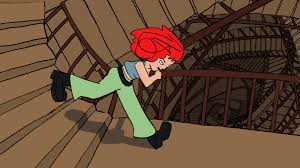I got as far as I could with the editing before I went insane 👍
Category: video essay
Carrick – Blog Post 6 (Video Essay)
While watching the assigned video essays this week, one concept resonated with me more than anything else: the idea of “therefore, but,” introduced in the F for Fake video. It felt like an “aha” moment. This technique—structuring a narrative so that each point logically follows or subverts the last—seems to be the backbone of the most compelling video essays I’ve come across.
One video that has stayed with me for some time is “Games you can never play again.” by The Cursed Judge. It exemplifies this “therefore, but” structure beautifully. Rather than diving straight into analysis of multiplayer games or the implications of the title, the creator begins with a seemingly unrelated story. That story unfolds into another, and another. Each thread is connected—not obviously, but emotionally and thematically. As the video continues, earlier moments are revisited in subtle ways, creating a satisfying sense of continuity and curiosity. You keep watching, not because you’re being told something directly, but because the pieces slowly form a larger picture.
The video is also a great example of how image and language work together. The voice-over is calm and reflective, never rushed. The clips shown on screen aren’t random; they’re carefully chosen to enhance the emotion or context of what’s being said. The visuals aren’t just decoration—they’re evidence, memory, and metaphor all at once. The use of music and ambient sound adds even more emotional depth, helping to guide the viewer’s feelings without ever becoming manipulative.
That said, I think I would take a very different approach to my own video essay. I’d aim for a blend of styles inspired by creators I enjoy, with a stronger focus on humor and a tone that doesn’t take itself too seriously. While the “therefore, but” structure works beautifully for longer, narrative-driven essays, I think shorter videos—like the 1- to 2-minute format for this assignment—lend themselves better to something playful, punchy, and more experimental in tone than deeply reflective or story-based.
Rylan Eisenhauer Blog Prompt #1 (Run Lola Run)
Run Lola Run clearly presents itself as a more experimental exploration of continuity and the awareness of time’s flow throughout the film. I appreciated these alternative approaches and ideas, which leave viewers feeling as though they can piece together what might happen next based on subtle details introduced earlier in each new “timeline.”
The film maintains its narrative and momentum by making details from the previous “runs” impactful, altering how the characters feel or what they know about a situation. The best example of this is in the first “run,” where, at the end, Lola exclaims that she doesn’t know how a gun works, prompting Manni to tell her to take the safety off. (See the image below.)

Then, once Lola resets into a new run, we, as the audience, assume it’s a completely fresh start where she loses all the knowledge she gained the first time. However, in the scene where she threatens her father at gunpoint, he exclaims, “You don’t know how to use that.” She then proceeds to take the safety off and fire the gun with ease. At this moment, we understand the rule: Lola is almost like a video game character, learning from previous attempts and failures. (See the image below.)

This film drips with intensity and suspense, with time being the most crucial factor at play. Each decision Lola makes could either help her save Manni or, as we see in other scenarios, lead to his or her death. The importance of time also permeates other aspects of the film, such as the recurring presence of the number 20. Lola has exactly 20 minutes to reach Manni before he robs a bank, marking a near “no turning back” point. The number 20 also appears as the one she bets on in roulette.
Each decision in the film feels deliberate and is captured in a way that keeps the audience on edge. The use of slow motion in moments when a character dies, nearly achieves their goal, or experiences something impactful is particularly effective. This technique complements the film’s alternative visual style, such as the use of animation when Lola runs down the stairs. The animated sequence ensures Lola remains visible in every frame, effectively portraying both her speed and the urgency fueled by adrenaline.
Another notable detail about the animation is the depiction of the staircase. The bottom is never shown, and the animation loops several times, creating the illusion that Lola isn’t getting any closer to the end. This choice emphasizes the immense distance she must cover to save Manni, further heightening the tension.

As a final thought from my first viewing, I found myself questioning the point of the flashback changes for the minor characters Lola bumps into. While it is intriguing to see how their lives unfold differently based on small changes, it doesn’t significantly alter how Lola interacts with them. Perhaps another watch of the film would help me better understand those segments. That said, the rest of the film was highly entertaining, and I enjoyed feeling involved in piecing together how the “rules” of the film worked.
-Rylan Eisenhauer